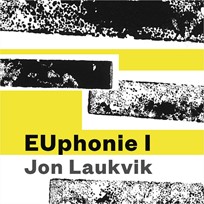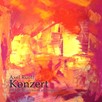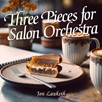
EUphonie I
Composer: Jon Laukvik
Instrument: Percussion Ensemble and Organ
Level: Advanced
Published: 2014
Price: €30.00
Item details
-
Description +
-
Duration: 9 min.
My colleague, friend, and mentor Werner Jacob († 2006) commissioned this piece in the middle of the 1980es. He played the first performance in the church of St. Sebald, Nuremberg; my colleague Klaus Treßelt conducted. I thank Klaus warmly for his commitment to this piece through many years.
The letters EU in the title has no political significance. In German music terminology, E means ernste Musik (“serious music”) and U Unterhaltungsmusik (“entertainment music”). This piece wants to offer both aspects. The combination of the two letters, EU, means “good” in Greek language. Euphonie therefore means “well sounding”.
-
-
Instrumentation +
-
Percussionist I:
2 Cow-bells (f sharp, g sharp)
1 Cymbal (suspended)
3 Antique Cymbals
2 Temple Blocks
2 Bongos
Whip
Marimba (shared with perc. II)
Percussionist II:
Xylophone
Glockenspiel
Flexatone
Rattle
Guiro
Marimba (shared with perc. I)
Percussionist III:
Marimba Vibraphone (shared with perc. IV)
Triangle
Percussionist IV:
Vibraphone
Castanets
Tubular bells
Tambourine
Percussionist V:
4 Kettle Drums (G/C/A/A)
Glass Chimes
Organ
-
-
About the composer +
-
Jon Laukvik was born in 1952 and received his earliest music training as organist and pianist in his native town Oslo. He went on to study organ at the University of Music in Cologne with Michael Schneider and harpsichord with Hugo Ruf. He also studied organ privately with Marie-Claire Alain in Paris.
From 1980 till 2016, he was professor at the University of Music and Performing Arts Stuttgart. Since 2001 he is also professor at the Norwegian Academy of Music in Oslo. He is also a visiting professor at the Royal Academy of Music, London.
Jon Laukvik has toured throughout Europe, Canada, Japan, Korea, Israel and the United States. He is frequently in demand to serve on competition juries and to teach seminars and masterclasses.
He is author of a highly successful organ tutor Historical Performance Practice in Organ Playing in three volumes, published by Carus-Verlag.
He has edited the Handel Organ Concerti Op. 7 for Carus-Verlag (together with Werner Jacob). A complete edition of the organ works of Louis Vierne in 13 volumes (edited together with David Sanger) was published by Carus-Verlag in 2008.
His compositions include works for solo organ, organ with other instruments (i.e. piano, percussion, trumpet, trombone, cello, horn) as well as vocal and instrumental works.
-
-
Reviews +
-
Percussive Notes, November 2016
The organ is not an uncommon instrument to be paired with percussion. A number of pieces from duets through large percussion ensembles have joined these instruments together, with the Lou Harrison “Concerto for Organ with Percussion Orchestra” probably being the most famous. With this latest contribution to the repertoire, “EUphonie I,” Jon Laukvik has created an interesting work that does a good job of combining these two worlds together into one entertaining, cohesive unit.
Beginning with a multi-percussion texture consisting of bongos, temple blocks, pitched cowbells, and a cymbal, the composer introduces listeners to much of the rhythmic language of the piece as well as roughly outlining some of the main themes of the work. Soon after, a marimba enters with a serpentine- like line based on a synthetic scale of minor 3rds and 2nds on which much of the piece is based. This line continues to be used in entrances by the organ and xylophone, creating an interesting interplay between all of these instruments. Laukvik does a beautiful job of orchestration by allowing each instrument to contribute its own voice before combining with the other.
Once these colors are established the organ begins to break away and contribute a much different set of material. Many times these gestures are polyrhythmic in nature, consisting of quintuplets, triplets, and nine-note groupings against the running sixteenth notes of the mallet lines. The composer has orchestrated these sections very well, allowing the organ to never be covered by the percussion due to dense scoring or pairing the instruments within the same frequency spectrum.
One of the strengths of this work is the identifiable themes that the piece is based around, such as the opening scale in the marimba or the first timpani entrance, which highlight much of the building material for the work. These motives along with others are continually developed through the work, and yet are still identifiable even in later uses.
Another strength lies in the organ writing. The composer is an accomplished organist himself, and this shows through his understanding of the instrument both in terms of idiomatic technique as well as his indications in the score. All indications for which stops to use and adjustments made to the color of the organ are clear, and ample time is given to handle the logistics of these changes.
Given the arsenal of instruments needed in the percussion alone, as well as finding a space with an organ that could work for this type of ensemble, the challenges in preparing “EUphonie I” are substantial. However, those performers who can work their way past these will find a well-crafted work that will be worth the efforts.
—Brian Nozny
-
-
Credits +
-
Front cover graphics: Sune Kliborg Lynge (Kliborg Design)
Printed in Copenhagen, Denmark
Copyright © Edition SVITZER
Engraving: Johan Svitzer
www.editionsvitzer.com
-





